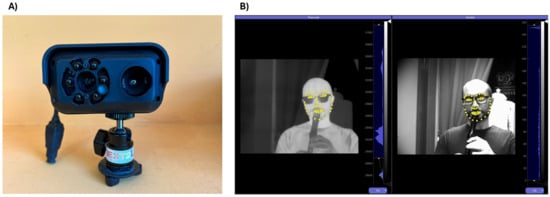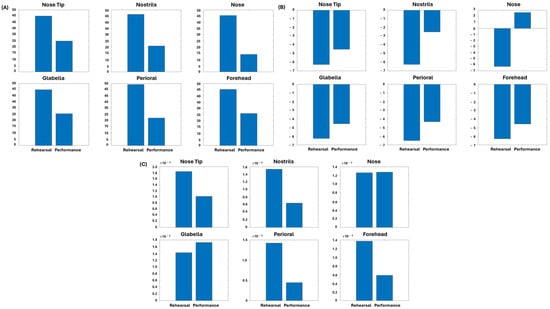Abstract
Performance anxiety is a common issue among musicians, and it could be fundamental to monitor their psychophysiological states during performances through non-invasive methods to support them in managing anxiety. Hence, infrared thermography (IRT) could be a valuable tool for this purpose. The study aims to assess whether IRT can effectively monitor musicians’ psychophysiological states. The facial temperature of four musicians was recorded during two conditions: rehearsal and live performance. The temperature time course was extracted from 3 regions of interest (ROIs) (i.e., forehead, nose tip, and perioral), and the following metrics were computed: skewness, kurtosis, and sample entropy. Moreover, machine learning models were applied to evaluate the presence of stress and the balance between sympathetic and parasympathetic systems. The results showed notable changes in thermal metrics in all the ROIs. Moreover, the prevalence of the sympathetic system for 50% of the rehearsal and 92% of the live performance durations was assessed. Additionally, the presence of elevated stress indicators was assessed for 6% of the duration of the rehearsals and 9% for the live performances. These results demonstrated the capability of IRT to assess modifications of the psychophysiological state of the musicians secondary to the condition of the performance.
1. Introduction
Music performance anxiety (MPA) is a significant challenge faced by musicians, impacting their overall performance quality and psychological well-being [1]. Musicians frequently report symptoms such as palpitations, sweating, and other forms of physiological arousal during performances, which are indicative of heightened anxiety levels [2]. Such experiences can compromise both their technical skills during performances and their emotional mental health, leading to a cycle of stress and underperformance.
In this context, it could be beneficial to adopt non-invasive methods for monitoring the psychophysiological states of performers during live situations. To this aim, infrared thermography (IRT) can be a suitable tool to assess the psychophysiological conditions of musicians during concerts thanks to its non-invasive and contactless features [3]. IRT enables the measurement of surface temperature variations, which can reflect emotional and stress-related states. The use of IRT can be particularly beneficial during rehearsals and live performances, as it provides real-time feedback and allows musicians to engage more with their emotional and psychological states as they perform. Notably, the capability of IRT to infer the emotional status of individuals can be increased by employing machine learning (ML) algorithms [4].
The present study aims to assess whether IRT can effectively monitor musicians’ psychophysiological states during rehearsals and live performances by exploiting ML approaches.
2. Materials and Methods
The facial temperature of four musicians (1F, age: 28 ± 9 years) was recorded during rehearsal and live performance through a physiological module called HIRA developed by Next2u s.r.l. (www.next2u-solutions.com) (Figure 1A) and composed of co-registered RGB and Infrared cameras [5]. This module enables real-time monitoring of individuals’ emotional states using ML models that analyze thermal features derived from specific facial regions of interest (ROIs) [6]. The temperature time course from 6 ROIs (i.e., nose tip, nostrils, nose, glabella, perioral, and forehead) was evaluated through an embedded tracking algorithm (Figure 1B), and the following metrics were computed: skewness, kurtosis, and sample entropy. Moreover, the embedded HIRA ML models that are able to evaluate the presence of stress and the balance between sympathetic and parasympathetic systems, trained and tested in Russo et al., 2023 [6], were used. Notably, the HIRA module was placed on the music stand at a distance of 60 cm. Although the musician does not always remain in the same position during the performance, reliable measurements can be obtained within a range of ±25 cm in distance and ±15° in angle [7]. Importantly, the emissivity of the skin was set to 0.98.

Figure 1.
(A) HIRA module for thermal imaging acquisition and affective computing assessment, (B) facial landmarks tracked by the HIRA module for the region of interest evaluation.
3. Results
The results showed notable changes in thermal metrics in all the ROIs: kurtosis decreased by around 45% (Figure 2A), skewness increased by around 30% (Figure 2B), and sample entropy decreased by around 80% (Figure 2C), when comparing the rehearsal and the performance.

Figure 2.
(A) Kurtosis, (B) skewness, and (C) sample entropy evaluated on the 6 regions of interest during rehearsal and performance.
The ML-based algorithms showed a prevalence of the sympathetic system for 50% of the rehearsal and 92% of the live performance durations (Figure 3A). In addition, the presence of elevated stress indicators was present for 6% of the duration of the rehearsals and 9% for the live performances (Figure 3B).

Figure 3.
(A) Distribution of the sympathetic dominance and (B) stress level for the rehearsal and performance conditions.
4. Discussion and Conclusions
This study provides novel insights into the use of IRT as a tool for monitoring the psychophysiological responses of musicians during rehearsal and performance. By analyzing facial temperature variations and applying ML models, an evident modulation of sympathetic activity and stress levels between rehearsal and live conditions has been assessed [8]. These findings highlight the potential of IRT for scientific understanding but also for practical applications in music education and therapy. Importantly, the results suggest that even subtle shifts in performance context can yield measurable physiological responses. Such approaches may help musicians build self-awareness and resilience through biofeedback-informed training. Overall, the research paves the way for a deeper integration of technology into the artistic process, supporting well-being and expressive freedom.
Author Contributions
Conceptualization, D.P., G.F.P., D.D.T., P.B., A.M. and M.T.; methodology, D.P., G.F.P., D.D.T. and M.T.; software, D.P. and A.M.; validation, D.P., G.F.P., D.D.T., P.B., A.M. and M.T.; formal analysis, D.P., G.F.P., D.D.T., P.B., A.M. and M.T.; investigation, D.P., G.F.P. and D.D.T.; resources, A.M. and M.T.; data curation, D.P.; writing—original draft preparation, D.P.; writing—review and editing, D.P., G.F.P., D.D.T., P.B., A.M. and M.T.; visualization, D.P., G.F.P. and D.D.T.; supervision, M.T.; project administration, M.T. All authors have read and agreed to the published version of the manuscript.
Funding
This research received no external funding.
Institutional Review Board Statement
The study was conducted in accordance with the Declaration of Helsinki and approved by the Territorial Ethics Committee of Regione Abruzzo (C.Et.R.A) (Prot. 0048263/24 of 06/02/2024).
Informed Consent Statement
Informed consent was obtained from all subjects involved in the study.
Data Availability Statement
The data presented in this study are available upon request from the corresponding author.
Acknowledgments
The authors would like to thank Next2u S.r.l. for providing the HIRA system and for their valuable technical support throughout the project. Their contribution was essential to the successful completion of this study.
Conflicts of Interest
Author Di Teodoro, D., was employed by the foundation Jeunsse Musical Italia. The remaining authors declare that the research was conducted in the absence of any commercial or financial relationships that could be construed as a potential conflict of interest.
References
- Taborsky, C. Musical Performance Anxiety: A Review of Literature. Update Appl. Res. Music Educ. 2007, 26, 15–25. [Google Scholar] [CrossRef]
- Mazzon, L.; Passarotto, E.; Altenmüller, E.; Vercelli, G. Music Performance Anxiety and the Italian Sport Psychology S.F.E.R.A. Model: An Explorative Study on 77 Professional Musicians. Psychol. Music 2024, 52, 322–339. [Google Scholar] [CrossRef]
- Cardone, D.; Merla, A. New Frontiers for Applications of Thermal Infrared Imaging Devices: Computational Psychopshysiology in the Neurosciences. Sensors 2017, 17, 1042. [Google Scholar] [CrossRef]
- Calderon-Uribe, S.; Hernández, L.A.M.; Guzman-Sandoval, V.M.; Dominguez-Trejo, B.; Albarrán, I.A.C. Emotion Detection Based on Infrared Thermography: A Review of Machine Learning and Deep Learning Algorithms. Infrared Phys. Technol. 2024, 145, 105669. [Google Scholar] [CrossRef]
- Tomasino, D.; Chinthakindi, M.; Tiberio, A.; Patibandla, C.; Tritto, M.; Nocco, S. Assessment of Cognitive Workload During Flight Training by Means of Hybrid NIR/LWIR Imaging. In Proceedings of the 2023 IEEE International Workshop on Technologies for Defense and Security (TechDefense), Rome, Italy, 20–22 November 2023; pp. 66–70. [Google Scholar]
- Russo, S.; Lorusso, L.; D’Onofrio, G.; Ciccone, F.; Tritto, M.; Nocco, S.; Cardone, D.; Perpetuini, D.; Lombardo, M.; Lombardo, D. Assessing Feasibility of Cognitive Impairment Testing Using Social Robotic Technology Augmented with Affective Computing and Emotional State Detection Systems. Biomimetics 2023, 8, 475. [Google Scholar] [CrossRef] [PubMed]
- Vardasca, R. The influence of angles and distance on assessing inner-canthi of the eye skin temperature. Thermol. Int. 2017, 27, 130–135. [Google Scholar]
- Perpetuini, D.; Russo, E.F.; Cardone, D.; Palmieri, R.; Filippini, C.; Tritto, M.; Pellicano, F.; De Santis, G.P.; Pellegrino, R.; Calabrò, R.S.; et al. Psychophysiological Assessment of Children with Cerebral Palsy during Robotic-Assisted Gait Training through Infrared Imaging. Int. J. Environ. Res. Public. Health 2022, 19, 15224. [Google Scholar] [CrossRef] [PubMed]
Disclaimer/Publisher’s Note: The statements, opinions and data contained in all publications are solely those of the individual author(s) and contributor(s) and not of MDPI and/or the editor(s). MDPI and/or the editor(s) disclaim responsibility for any injury to people or property resulting from any ideas, methods, instructions or products referred to in the content. |
© 2025 by the authors. Licensee MDPI, Basel, Switzerland. This article is an open access article distributed under the terms and conditions of the Creative Commons Attribution (CC BY) license (https://creativecommons.org/licenses/by/4.0/).